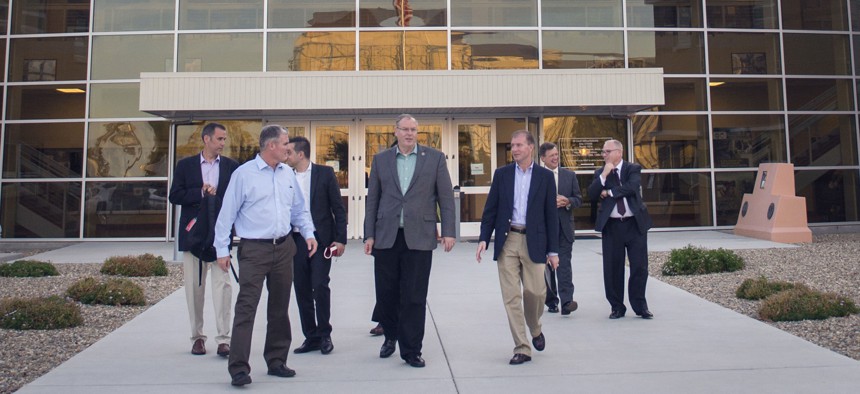
Deputy Defense Secretary Robert Work walks with defense officials outside of the Pentagon's Defense Innovation Unit-Experimental in Silicon Valley. MSgt Adrian Cadiz/DOD
Pentagon Sends an Engineer and a Navy SEAL to Woo Silicon Valley
Not five months after its announcement, the military’s California technology-hunting office is up and running.
MOUNTAIN VIEW, Calif. – Less than five months since Defense Secretary Ash Carter announced that the Pentagon would open a Silicon Valley office, an engineer and a Navy SEAL are already working to persuade the government-weary tech community to partner with the military.
Their new office, dubbed the Defense Innovation Unit-Experimental — DIUx for short — occupies a building near Moffett Federal Airfield’s massive WWII-era airship hangars. By Pentagon standards, it has materialized at light speed. Still, “The secretary would say that we’re too slow,” Deputy Defense Secretary Robert Work said aboard a westward flight to the new office.
Work and Pentagon acquisition chief Frank Kendall met late Tuesday with the men in charge of the new office. George Duchak, the DIUx director, has worked at the Air Force Research Laboratory, DARPA, and in the private sector, Work said. His military deputy, Rear Adm. Brian Hendrickson, is a Naval Academy graduate with an MBA from Harvard and experience with SEAL teams and U.S. Special Operations Command.
Both have experience in the technology sector and working with startups. Both, Kendall said, were picked in large part for their entrepreneurial mindsets. Their goal is to meet with tech companies in search of commercial technologies the military might find useful, or commercial components to make existing military equipment better.
“This is a point of presence where we want people in the Valley to be very comfortable going to the same faces over and over and over again,” Work said.
The Silicon Valley office — located next to a military airfield now leased by Google — is part of a broader push by the Pentagon to find technologies that will give troops an edge on the battlefield of the future. Among the technologies being eyed are in the areas of robotics, additive manufacturing, big data analytics and cyber. “It’s just that there are more dual-use technologies that are being driven by the commercial sector that we want to tap into,” Work said.
“We’ll learn a lot about what technologies are emerging in the high-tech world and they’re going to learn a lot about what we need,” Kendall said.
Beyond technology, the Pentagon also wants to learn how to organize for speed and agility. “We want to get ideas on how they approach innovation,” Work said.
But tech firms have been skeptical of the Pentagon’s outreach for numerous reasons. Some fear the Defense Department might steal its intellectual property. Other object to working with the military in the wake of former contractor Edward Snowden’s revelations of government snooping.
“We need to prove to the Valley that we aren’t this big ponderous beast — that we can turn some things certainly a little faster if they are very promising, have good technology behind them and we see a way to get there,” Work said.
Kendall reiterated — he has said this frequently in recent months — that the Pentagon is not looking to confiscate anyone’s ideas or work. “We want to make sure people understand that we’ll respect their intellectual property,” he said.
Carter, who came to Silicon Valley in April to tout the effort, will head back here later this month to visit the new office.
NEXT STORY: US Marines Say F-35 is Ready for War
